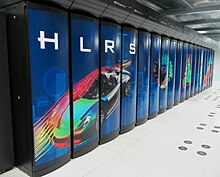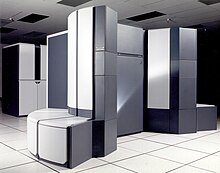Cray
| Cray Inc.
|
|
|---|---|
| legal form | Corporation |
| ISIN | US2252233042 |
| founding | 1972 |
| Seat |
Seattle , Washington , United States |
| management | Peter J. Ungaro |
| Number of employees | 1000 (2012) |
| sales | $ 421 million (2012) |
| Branch | Hardware manufacturer |
| Website | www.cray.com |
Cray Inc. is a company founded in 1972 by Seymour Cray under the name Cray Research .
The company manufactures supercomputers whose computing power is now in the PFLOPS range (1 PFLOPS = 10 15 floating point calculations per second).
history
1976: vector calculator

Cray delivered the first supercomputer in 1976 with the Cray-1 , a computer with a performance of around 133 MFLOPS . The Cray-1 had a word size of 64 bits and a memory expansion of one million words, which corresponds to a memory size of 8 megabytes. The cycle time was 12.5 nanoseconds , corresponding to a clock frequency of 80 MHz, which was extremely high for the time .
Until the mid-1980s, Cray only manufactured vector computers . The computing power of these computers lies neither in their clock frequency nor in the interconnection of several CPUs. Instead, the CPU has several vector registers which, in the case of Cray, can hold 64 values at once. With several vector registers, instructions on 64 values can be executed simultaneously within one clock cycle.
1993: Parallel computers
Seymour Cray resisted the introduction of multiprocessor capabilities for a long time ; in his opinion, a single but very fast CPU was superior to several slower CPUs. Limited multiprocessor capabilities were only introduced with the successor to the Cray-1, the Cray X-MP , which supported up to four CPUs.
In 1993 Cray's first massively parallel computer, the Cray T3D , was shipped. The T3D was based on the Alpha processor from DEC and supported up to 2048 processors. The CPUs of the T3D and the successor model T3E were interconnected in the topology of a 3D torus .
Starting with the Cray-2, Cray delivered the Unicos operating system , a Unix- compatible timeshare operating system. This enabled users to work on the supercomputer itself in an environment they were familiar with from their desktop workstations .
In cooperation with Sun Microsystems , Cray developed the Cray CS6400 , a system with up to 64 SuperSPARC CPUs that could be dynamically divided into several partitions. The CS6400 was one of the first massively parallel systems to use a standard operating system (in this case Solaris ) and was therefore also suitable for use with business applications.
The first Cray machines were made using germanium - semiconductor technology. Due to the high level of waste heat, aluminum blocks through which the cooling liquid ran were clamped directly to the circuit boards. Later machines (including the Cray-2 , Cray-3 , Cray-4 and Cray T90 ) were immersion cooled: the circuit boards floated in a bath made of Fluorinert ( perfluorocarbon ), an electrically non-conductive cooling liquid. A well-known quote goes that Cray is basically a refrigerator company.
Physical requirements for a supercomputer also dictated other parts of the design. With the Cray-1, the uniform length of the connecting cables between the individual circuit boards had to be precisely adhered to in order to ensure correct timing. The solution was a housing in the design of a column with a round seating group facing outwards: the column contained the circuit boards, while the bench housed the cooling units. The Cray-2 was also built in a columnar shape to ensure minimal paths between the individual components of the computer. These features made Cray a cult , a Cray machine was just different .
In 1996 Cray Research merged with Silicon Graphics (SGI) .
Since 2000
In March 2000, Cray Research was sold to Tera Computer Corporation , which was renamed Cray Inc. after the sale was completed on April 4, 2000. Since then, supercomputers have been manufactured again under the Cray name.
In 2004 the Red Storm system (now 204.2 TFLOPS ) was completed for Sandia National Laboratories . The architecture used in it for supercomputers was introduced commercially in Cray XT3 and further improved with Cray XT4 and Cray XT5 . A corresponding “Jaguar” system from Oak Ridge National Laboratory took 6th place on the TOP500 list of supercomputers in June 2012 with a speed of around 1,941 petaflops . Also in June 2018, a Cray XC50 computer at the Swiss National Supercomputing Center was in 6th place with 25.3 PFlops.
Cray's technology found its way into a number of high-performance computers from other manufacturers. SGI used Cray technology to improve the high-speed connections introduced for the Origin2000 for the Origin3000 . With these connections, up to 2048 processors in the Origin3000 are coupled to form a ccNUMA system. The fact that the connections of the Origin2000, introduced in 1996, were called CrayLink was pure marketing, SGI had just acquired Cray Research.
The technology of the Cray CS6400 was further developed by Sun Microsystems and forms the basis of the Sun E10000 .
In 2019, Hewlett Packard Enterprise (HPE) acquired Cray. For this, 1.4 billion US dollars were offered.
List of computers
Cray Research
(1972-2000; 1996-2000 belonging to SGI )
- Vector processor systems:
- Entry-level systems:
- MPP systems:
- Cray Research Superservers:
Cray Computer Corp.
(1989-1995)
Cray Inc.
(2000 – present; result of the merger between Tera Computer Company and Cray Research)
| model | idea | Previous model |
|---|---|---|
| Cray SX-6 | ||
| Cray MTA-2 | Cray MTA | |
| Cray Red Storm | 2004 | - |
| Cray X1 | 2003 | - |
| Cray X1E | 2005 | Cray X1 |
| Cray XT3 | 2004 | Cray Red Storm |
| Cray XD1 | 4th October 2004 | - |
| Cray XT4 | November 18, 2006 | Cray XT3 |
| Cray XMT | Cray MTA-2 | |
| Cray X2 | ||
| Cray CX1 | September 16, 2008 | - |
| Cray XT5 | November 6, 2007 | Cray XT4 |
| Cray XT6 | November 16, 2009 | Cray XT5 |
| Cray XE6 | May 25, 2010 | Cray XT6 |
| Cray CX1000 | ||
| Cray XK6 | May 2011 | Cray XE6 |
| Cray XK7 | October 29, 2012 | |
| Cray XC30 | ||
| Cray XC30-AC | May 7, 2013 | Cray XC30 |
| Cray XC40 | October 2014 | |
| Cray XC50 | 2016 | Cray XC40 |
Web links
- The company's website (English)
- CRAY pages of the ComputerMuseum Munich (English)
Individual evidence
- ↑ cray.com (PDF)
- ↑ investors.cray.com
- ↑ Red Storm System in the TOP500 list (in English) ( Memento of the original from March 21, 2011 in the Internet Archive ) Info: The archive link was inserted automatically and has not yet been checked. Please check the original and archive link according to the instructions and then remove this notice.
- ↑ TOP500 list of the most powerful supercomputers from June 2012 (in English)
- ↑ June 2018 | TOP500 supercomputer sites. Accessed August 29, 2018 .
- ↑ faz.net: Billion takeover in the supercomputer industry , accessed on May 20, 2019
- ↑ Cray News Release, May 7, 2013: Cray Expands Line of Cray XC30 Supercomputers With New Technical Enterprise System

